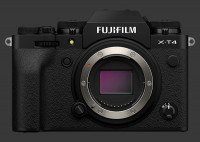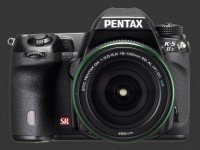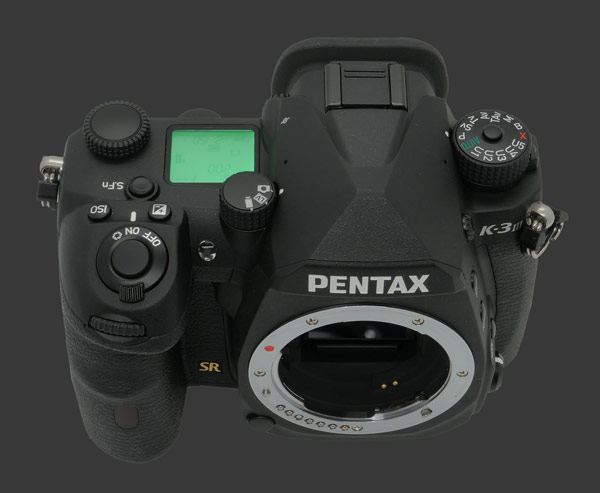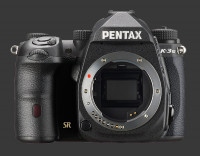Pentax K-3 III Review
Pentax K-3 III Performance - How well does it take pictures?
Ultimately, image-quality is what makes a camera worth buying. For a digital SLR, it greatly depends on the lens used. While image-noise, exposure, color, white-balance and contrast are properties of the camera, distortion, vignetting, chromatic aberrations are properties of the lens. Sharpness depends on the weakest link. That is, a camera cannot capture more details than its lens lets through. Conversely, it is possible that a lens transmits more details than the sensor can capture.

Image Noise & Detail
The newly developed sensor inside the Pentax K-3 III easily matches expectations of a modern APS-C digital camera. This sensor has a Bayer Color Filter-Array without an Anti-Alias Filter to maximize the recorded detail. With a sufficiently sharp lens stopped down to its optimal aperture, the K-3 III captures extremely fine detail to the maximum level currently possible with an APS-C sensor.
Amazingly, images from the K-3 III are virtually noise-free from its base ISO 100 sensitivity until ISO 1600. At any of these sensitivities, prints up to 27" x 18" come out looking sharp and perfectly clean. Upon close inspection at 100%, just a hint of noise can appear at ISO 1600 when photographing in very low-light. Even then, 24" x 16" prints come out looking beautiful and crisp. This Anti-Alias Filter-Free sensor renders detail optimally with Fine Sharpness set to +2. Even one level higher images remain virtually free of sharpening evidence.
Images captured at ISO 3200 start showing minimal noise which is only visible at large sizes. Noise is fine and strictly affects luminance which makes it fairly easy to correct via image processing software. More importantly, the K-3 III manages to maintain color and contrast very well. This sensitivity is perfectly usable for moderately large prints given these are produced from 26 MP images.

There is a non-trivial jump in image-noise at ISO 6400 that starts damaging the finest detail. Adjustable High ISO Noise-Reduction can trade off some noise for softness yet does not effect possible prints sizes much. Expect ISO 6400 to be completely usable for common print sizes and look quite clean at 18" x 12" but with a little softness from noise-reduction. Again, color and contrast stay inline with lower ISO settings.
ISO 12800 is very impressive for an APS-C sensor yet undeniably noisy. Noise remains limited to the luminance channel, while both color and contrast are stable. Fine detail get slightly damaged but not overly so, leaving ISO 12800 quite usable for typical prints and online use. For those searching for the ultimate APS-C image-quality: This is the inversion point between the Pentax K-3 III and the Fujifilm X-T4
Fujifilm X-T4. Both cameras offer very similar image-quality, with the K-3 edging out the X-T4 until ISO 6400, inclusively. From ISO 12800 to 51200, the maximum possible on the Fujifilm, output from the X-T4 is slightly cleaner.
There is another jump of noise at ISO 25600 which eats away at fine details. The noise pattern still affects luminance only is coarser than the at ISO 12800..One can produce some reasonable mid-size prints, A 12" x 8" looks good but not completely smooth. Smaller print sizes though come out looking great. ISO 51200 really destroys detail and has to be significantly downsized to get acceptable prints. It is usable for standard 4" x 6" prints though. Only ISO 102,400 remains that can produce such small prints reasonably.
The ISO 204800 sensitivity barely makes a recognizable subject. It shows very grainy luminance noise and dramatically reduces contrast. Only a handful of APS-C cameras reach this level, so it is there for emergency. All higher sensitivity are just there to show up on specifications. Noise is extreme and contrast is very low. Colors start shifting at ISO 409600 too. ISO 819200 and 1638400 could pass for abstract art!
By switching to Pixel-Shift mode, the Pentax K-3 III creates a full-color image by shifting the sensor to capture a 2x2 grid of images offset by a single photosite. While this is designed to improve color-accuracy, it reduces image-noise by average four images. At low ISO settings, the difference is not noticeable. From ISO 1600 onward though, an advantage slightly over 1-stop is created. ISO 1600 becomes perfectly smooth and more detailed, which is comparable to ISO 400. At ISO 3200, Pixel-Shift closely resembles ISO 1600.
Pixel-Shift becomes interesting starting at ISO 12800 that can handle a fairly large print, while ISO 25600 is fine for common print sizes. ISO 51200 is only slightly more restrictive. Raising ISO further with Pixel-Shift enabled makes it possible to obtain a small usable print at ISO 204800. A tripod is required, so this is not that useful since it is generally easy to extend the exposure when the camera is mounted on a tripod.
The Pentax K-3 has exceptionally flexible Noise-Reduction settings. Independently for each ISO, NR can be disabled or set to one of 3 levels. There is virtually no difference between the output of Off and Low until ISO 800. At ISO 1600 and 3200, Medium delivers a very slight improvement. Between ISO 6400 and 51200, the High level produces minimally better images. From ISO 102400 onward, the Medium setting fares better though, since High introduces excessive softness.

Exposure & Dynamic-Range
With remarkably low noise, the new 26 Megapixel APS-C BSI-CMOS sensor inside the K-3 III captures dynamic-range similar to the class-leading Pentax K-5 IIs
Pentax K-5 IIs once more! While the K-3 II offers a similar resolution, its per-pixel light-gathering area is restricted by circuitry and so it only managed 13½-stop of dynamic-range. In comparison, the K-5 IIs managed 14 EV. The Pentax K-3 III is also capable of capturing scenes with 14-stop dynamic-range, giving it performance only exceeded by latest-generation Fujifilm X-series cameras.
Dynamic-Range exceeds 14-stops at the base ISO 100 sensitivity and stays stable until ISO 800 when Highlight Correction is enabled. ISO 1600 captures a broad dynamic-range too, about 13¼ EV. Each additional ISO stop diminishes maximum dynamic-range slightly with larger losses when crossing ISO 25600 and 102400. This is very good for an APS-C sensor and very close to class-leading.
Metering is powered by a new 307K RGBI sensor. Its output is processed by the PRIME V engine that detects color distribution, shapes and scenes. This works to perform Multi-Segment metering and Highlight Weighed Metering, which is new to the Pentax K-3 III. There are also standard Center-Weighed and Spot metering modes that work exactly as expected.
The new Multi-Segment metering system is generally reliable and produced balanced exposures under a variety of conditions. Its weighing is somewhat conservative which results in dim low-contrast scenes while minimizing highlight clipping under most conditions. Unfortunately, there are cases of severe over-exposure that happen in both bright and low light conditions. This occurs in about 2% of images which is definitely high. This issue happened even more often with the original firmware and so, hopefully, will be corrected in the next.
Color & White-Balance
Flexible image-parameters allow photographers to fine-tune colors with tremendous latitude. Both Bright and Natural render realistic hues with different saturation. Best results are achieved using Bright color mode at its default settings. This produces realistic yet not completely accurate colors. Any adjustment in Hue or Saturation shifts the difference without becoming true-to-life. Capturing in RAW is required for color-critical work.
Colors in Bright mode have great depth and can handle a +1 boost in saturation for extra punch without looking artificial. Natural gives a far more subdued look and really needs contrast dialed up +2 steps. Default contrast varies by color mode with zero being somewhat flat which is why Bright starts at +1.
Pentax provides extreme white-balance flexibility on the K-3 III. The AWB system corrects for lighting from a single illuminant type automatically with an option to preserve some warmth under tungsten lighting. The more complex scenes, a unique Multi-Source Automatic White-Balance mode corrects lighting by segment to produce a neutral image under mixed light sources. This system shows excellent WB accuracy. Going the other way, a unique CTE white-balance mode exaggerates color-shift to emphasize dramatic lighting.

Autofocus
Among the three most significant improvements of the Pentax K-3 III, stabilization, image-noise and autofocus, the latter is perhaps the most anticipated. Ricoh trailed manufacturers that cater to action photography for years. With its completely new 101-Point SAFOX XIII Phase-Detect Autofocus system, the K-3 III now offers a similar level of sophistication. SAFOX XIII comes with 25 Cross-Type points that are sensitive down to -4 EV.
This large number of autofocus points delivers a significant jump in tracking performance which allows the K-3 III to continuously autofocus at 11 FPS which sufficiently fast for professional action photography. Having so many tightly packed focus-points minimizes chances for subjects to fall between AF-points. The same 307K pixel sensor used for metering assists in recognizing moving subjects by consolidating color and brightness data between frames with motion prediction.
There are two components on every autofocus system, one is the focus distance measurement, the other is the Focus Driver. Pentax DSLRs have two Focus Drivers, a mechanically-coupled link that controls focus using a motor built into the camera and an electronic focusing system that sends focusing signals to the lens. The one used is determined by the lens. Most lenses support only one method yet a few have both the mechanical and electronic coupling.
Autofocus speed is highly variable due to these two drivers. Electronically driven lens typically focus quicker then those that rely on a mechanical coupling. Although, Pentax lenses driven mechanically outlast others by a huge margin. To ensure fast autofocus with the K-3 III, it is highly recommended to choose lenses with a builtin focus motor. Pentax labels those lenses as SDM, PLM or DC, depending on the type of motor used. SDM offers the fastest AF speed but is historically the least durable.
Using an electronic lens, the Pentax K-3 III can lock focus in 1/3s, even in moderately low-light. Mechanical lenses can focus anywhere between ½s and 1s depending on how much focus movement is required. Continuous AF can track reasonably well with a fast lens since it only needs very small adjustments between frames. In all cases, autofocus is highly accurate and focus misses with relatively still subjects are rare. Even though AF-C is available up to 11 FPS, subjects moving quickly or erratically can trigger a high-percentage of unfocused frames. An option on the K-3 III lets the camera lower its frame-rate in favor of focus-accuracy.
Speed & Performance
Every operation on the Pentax K-3 III triggers an immediate response. All buttons, dials and menu respond instantly. Outside of heavy processing for Pixel-Shift and Exposure-Fusion, this DSLR never slows down. Having an optical viewfinder means that there is zero lag when framing subjects or adjusting focus. The speed of this flagship camera is impressive:
- Power On: Almost instant. Superb!
- Power-On to First-Shot: ½s. Really good.
- Autofocus: 1/3-1s, highly variable by lens. Good to slower than average.
- Shutter-lag: Instant with virtually no blackout. Very impressive! A huge improvement.
- Shot-to-shot: ¼-1/3s. Good with AF variability.
- Playback: Immediate to enter or exit. Fantastic.
- Video: Instant to start or stop. Perfect.
- Power-Off: Instant. Great..
This is clearly one of the most solid performance from any digital camera. Autofocus is where the K-3 III shows some variability which affects measurements for shot-to-shot speed yet the average is good. Video performance is particularly impressive given so many cameras struggle with it.
Ricoh significantly improved image-stabilization on the K-3 III. The previous 3-axis system managed about 2-stops of Shake-Reduction but the new 5-axis system practically double this and reach 5½-stops under optimal conditions.
Focusing accuracy is superb and this DSLR rarely locks focus incorrectly. Compared to the K-5 IIs, both speed and sensitivity remain the same. The AF system is obviously more sophisticated can better at tracking but even so it tends to play catch up with subjects in motion, rather than keep them locked in focus. Combined with excellent High-ISO performance and any compatible lens, this makes the K-3 III one of the best APS-C cameras for low-light photography.
The final performance number of a battery-life of 800 shots-per-charge. While this is highly optimistic, the Pentax K-3 III manages at least half that many under typical usage. This is much better than the majority of APS-C cameras yet a little lower than average for a DSLR. A second battery should be sufficient for most full days of photography. Disabling the status display shown on the rear LCD helps extend battery-life, if needed. Speaking of battery, it is highly disappointing that a camera launched at $2000 USD or $2500 CAD does not ship with a charger. Professionals that buy this level of camera do not expect to have it tied-up while a charging.
Pentax K-3 III Performance - How well does it shoot video?
The K-3 III includes 4K video capability for the first time on a Pentax DSLR. Ricoh has been trailing other manufacturers that offer 4K since 2016 on some DSLRs. Ultra-HD is now ubiquitous, while this new flagship gets it in basic form. Professional photographers that branch into videography are better served by mirrorless cameras that allow video recording at eye-level and offer much more sophisticated video features. Still, providing 4K in the K-3 III allows its users occasionally record video.
Two video resolutions are supported by the Pentax K-3 III: 3840x2160 and 1920x1080, known as Ultra-HD and Full-HD, respectively. Frames ares are available until 60 FPS for Full-HD and 30 FPS for 4K. In all cases, the camera stops recording after 25 minutes or a video reaches 4GB, whichever occurs first. Videos are always saved in QuickTime format using an H.264 codec. Again, this is minimal and Ricoh does not even mention video features on the landing page for the K-3 III.
Video mode on this DSLR offers full manual-controls, with all standard exposure-modes plus TAv exclusive to Pentax. Color modes and WB control are virtually the same in Video and Photo modes, except that Multi-Source WB is not supported. It is also not possible to turn Highlight Correction On for video capture, although Auto could do it. Shadow Correction remains the same but Clarity and Skin Tone adjustments are not available for video. No reason is given, these options similar disappear after switching to Video mode.
Stereo sound is recorded with video. There is a builtin stereo microphone on top of the viewfinder housing, plus a standard 3.5mm mini-jack that supports stereo audio input from an external analog source. A second mini-jack provides stereo audio output for a headset. Audio input and output can be set in 40 levels. To disable audio capture, one must set the audio volume to zero.

Recording video with the Pentax K-3 III is completely straightforward. Once the capture dial is set to Video, the rear LCD immediately shows the correct framing corresponding to the selected video resolution. Given that the LCD has a 3:2 aspect-ratio and video is captured at 16:9, there is space for status information above and below the preview. Inexplicably, Ricoh wastes some horizontal space to show audio levels.
Full HD video from this DSLR is captured using the entire sensor-width and scaled from 26 to 2 MP, as required by 1080p. This oversampling results in very clear video with minimal noise and virtually eliminates moire-artifacts which are possible on the K-3 III since its sensor omits an Anti-Alias Filter in favor of resolution. This downsampling produces slightly soft 1080p video.
There is a significant reduction in field-of-view when switching to Ultra-HD. Images from a 26 MP sensor are 6192 pixels wide but 4K frames have 3840 pixels. Without using oversampling, this translates into a 1.6X crop. Given this is an APS-C sensor with a 1.5X crop already, the two compound. On the plus side, using pixels 1:1 to capture 4K produces very sharp and highly detailed video.
All videos from the K-3 III are encoded in Quicktime format with the H.264 codec. This camera only offers one compression level which is higher than most which makes video files take less space than average. This encoding does a really good job at compressing with minimal artifacts on scenes with little to moderate movement. When a large portion of the frame changes quickly, motion compression artifacts are visible.
It is nice that Pentax K-3 III records video for times when a video is more suitable than a photo, yet this not a camera to consider for videographers. The extreme field-of-view crop in 4K mode renders most lenses much more narrow than intended. Videos recorded at 1080p do not face the issue yet are visibly softer than expected for Full HD. Although full manual-controls are available, the camera restricts most advanced features for video.
Pentax K-3 III Conclusion

The new Ricoh flagship DSLR is nearly flawless and brings substantial improvements over its predecessors to numerous key features. The 26 megapixels APS-C BSI-CMOS sensor designed for the Pentax K-3 III delivers a truly exceptional performance that similar to current best-in-class cropped-sensor digital cameras. Its advanced 5-axis Shake-Reduction system compensates up to 5½-stops of shake compared to hand-holding, stabilizing all lenses to make the K-3 III the best low-light DSLR with an APS-C sensor. A vastly improved 101-Point Phase-Detect AF system and ultra-fast 12 FPS continuous drive add action-photography capabilities to this camera.
The Pentax K-3 III is an outstanding digital camera. Its image quality is superb with excellent detail, extremely low image-noise and beautiful colors that are highly adjustable. The AWB system delivers an exceptional level of sophistication to handle any lighting and even under a combination of light sources. Its dynamic-range is very broad and comes really close to best-in-class. While the metering system mostly selects optimal exposure, it severely overexposes occasionally. This is in fact the only flaw on this DSLR, other criticisms are imperfections.
As successor to the most feature-rich DSLR ever made, the Pentax K-3 III makes a few concessions. It mostly lost the builtin GPS which is now back to being an optional add-on. This DSLR packs an impressive amount of features with many unique and tremendously useful ones, including Automatic Horizon Correction, Composition Adjustment, Automatic Stabilization and Selective Memory. Very few other features truly improve photography!
Ergonomics of the K-3 III makes this the most efficient digital camera to date. Its combination of triple control-dials, 8-way focus joystick and dial with innovative exposure modes place every important photography features right at hand. Its chaotic menu system can easily be avoided by leveraging 10 customizable buttons and 20 configurable functions in the Control-Panel. The camera gives great feedback and displays customized controls to remind the photographer and encourage their use.
Ricoh created the largest optical viewfinder among APS-C DSLRs for the Pentax K-3 III. This one shows 1.05X magnification and 100% coverage for superior usability. An Eye-Start Sensor automatically disables the rear LCD while composing images to prevent glare. The construction of this DSLR make it incredibly durable. Its body is weatherproof and freezeproof down to -10C, plus it avoids the most common weak-point of modern cameras by fixing the rear LCD to the frame of the camera.
The Pentax K-3 III is undeniably a spectacular digital camera yet making a final recommendation is difficult due to its high price. For this reason, this conclusion must be unusually split into two:
Pentax User Conclusion
Everything the K-3 III achieves makes this conclusion easy. Current Pentax owners are certain to love this camera. Its image-quality, stabilization and speed all improved significantly to produce a worthy successor to all Pentax APS-C DSLRs.
The only truly lost feature can be restored by buying an optional GPS unit and the missing charger is likely already in the hands of most Pentaxians, as will be extra batteries. The leap realized by the new 26 MP sensor and 5-axis Shake-Reduction system make this DSLR superior for low-light photography compared to previous generations.
A larger viewfinder, an extra control-dial and joystick contribute to make this DSLR more efficient than ever, allowing quicker photography using a compact body that packs every feature needed by professionals and quite a few more.
The Pentax K-3 III is the Essential Recommendation for current owners of a K-mount system
General Conclusion
DSLRs are declining. Only 6 others were launched in the past two years, leaving the Pentax K-3 III almost without competition. In fact, none of all those recent models offers comparable capabilities.
This also makes for a simple conclusion: Those who want a cropped-sensor DSLR have no better option than the Pentax K-3 III. Buying Full-Frame instead implies a larger and heavier camera that requires bulkier lenses, so APS-C DSLRs offer great balance.
The picture is not so clear if mirrorless cameras are considered. When image-quality is the top priority, several stabilized Full-Frame mirrorless are smaller and lighter than the K-3 III. At least 5 of those cost the same! All offer dual control-dials in a weatherproof body and nearly all have a larger viewfinder too. Plus, there are tremendous advantages to an EVF.
Although the Pentax K-3 III is a fast DSLR, virtually all modern upper-range mirrorless cameras are much faster, making those the top choice for speed. When size is critical, mirrorless cameras easily win too.
This leaves few reasons for a photographer to invest into a Pentax K-3 III and lenses it requires:
- The Optical Viewfinder Experience™
- Unique features of this DSLR such as Astrotracer
- Unmatched ergonomics and efficiency
- Ruggedness of the Pentax K-3 III
 |
Please Support Neocamera
All information on Neocamera is provided free of charge yet running this website is a huge endeavor. Purchases made via affiliate links found throughout the site help keep it running and up-to-date. There is no additional cost to you, so please consider buying via these links to our affilates:
If you found any information on this site valuable and did not purchase via our affiliate links, please considering donating via PayPal:
Any amount will be greatly appreaciated. Thank you for your support!
Pentax K-3 III Highlights

Sensor-Size: 24 x 16mm

Actual size when viewed at 100 DPI
| 26 Megapixels DSLR | ISO 100-1600000 |
| Pentax K Mount 1.5X FLM | Shutter 1/8000-1200s |
| 5-Axis Built-in Stabilization, 5.5-Stop Improvement | Full manual controls, including Manual Focus |
| 100% Coverage Extra Large Viewfinder | Custom white-balance with 2 axis fine-tuning |
| Automatic Eye-Start sensor | Spot-Metering |
| Auto Horizon Correction 2 Axis Digital Level | Hot-Shoe & Sync-Port |
| Weatherproof down to -10C | Stereo audio input |
| Built-in Dust Reduction | Lithium-Ion Battery |
| 12 FPS Drive, 37 Images | Secure Digital Extended Capacity x 2 |
| 3840x2160 @ 30 FPS Video Recording | |
| 3.2" LCD 1.6 Megapixels |
Updates
2025.01.18

Fujifilm GFX 2025 Lens Roundup
Lens Review roundup of Fujifilm GFX Medium-Format lenses. Quality, performance and handling of the GF20-35mm F/4R WR, GF30mm F/3.5 Tilt-Shift and the GF55mm F/1.7.
2024.11.18

Best 2024 Photography Gifts for Every Budget
Great gifts for photographers and photo enthusiasts selected for every budget among the best products of 2024.
2024.08.07

Eye Protection Tips for Professional Photographers
The four main considerations for professional photographers regarding eyewear.
2024.07.14

Fujifilm X100VI Review
Flagship fixed-lens compact digital camera with a 40 MP sensor and Image-Stabilization, a first for the series. Retro design featuring dual control-dials, plus direct ISO, Shutter-Speed and EC dials. Its hybrid viewfinder can switch between EVF and OVF mode.
2024.05.09

Fujifilm GFX100 II Review
Flagship 102 Megapixels Medium-Format Mirrorless Digital Camera with 8-Stop 5-Axis IBIS, 8 FPS Drive, 8K Video and 400 MP Super-Resolution capture in a weatherproof and freezeproof body with dual control-dials and dual memory-card slots.
2024.04.03

Fujifilm X-T5 Review
Newest Fujifilm flagship boasting a 40 MP APS-C sensor, 5-axis IBIS with 7-stop efficiency, 15 FPS continuous drive, 6.2K Video capture, dual control-dials and dual SDXC UHS-II slots in a sturdy weatherproof and freezeproof body.
2023.11.20

Best Digital Cameras of 2023
Find out which are the Best Digital Cameras of 2023. All the new Mirrorless Digital Cameras from entry-level to high-end professional.
2023.07.10

Fujifilm X-H2 Review
40 Megapixels APS-C Hybrid Mirrorless Digital Camera with 7-stop IBIS. Fastest shutter ever and 8K video capture. Large builtin EVF with 0.8X magnification and 5.8 MP, plus an Eye-Start Sensor. Packed with features and large number of controls in a weatherproof and freezeproof body.
2023.05.07

Sony FE 20-70mm F/4G Review
Review of the unique Sony FE 20-70mm F/4G lens. The optical zoom of this lens spans ultra-wide-angle and medium focal-length coverage, making it one of the most versatile Full-Frame lenses on the market.
2023.01.15

Huion Inspiroy Dial 2 Review
Review of the Huion Inspiroy Dial 2 tablet, a medium sized drawing surface with dual dials and customizable buttons. Connects via USB-C or Bluetooth 5.0 with Windows, Linux and Android support.
2022.12.08

How to Pack for a Photo Trip
Find out how to pack for a travel photography trip, carry your gear safely while meeting airline regulations.
2022.11.13

Best Digital Cameras of 2022
The best digital cameras of 2022. A short list of the most outstanding models in their respective categories. Choose one for yourself or as a gift.













